Environmental Issues in Construction Projects
VerifiedAdded on 2022/12/19
|9
|1984
|69
AI Summary
This article discusses the environmental issues that can affect the construction and operations of a project. It highlights the importance of proper management and knowledge of these factors and explores the role of BIM in project delivery.
Contribute Materials
Your contribution can guide someone’s learning journey. Share your
documents today.
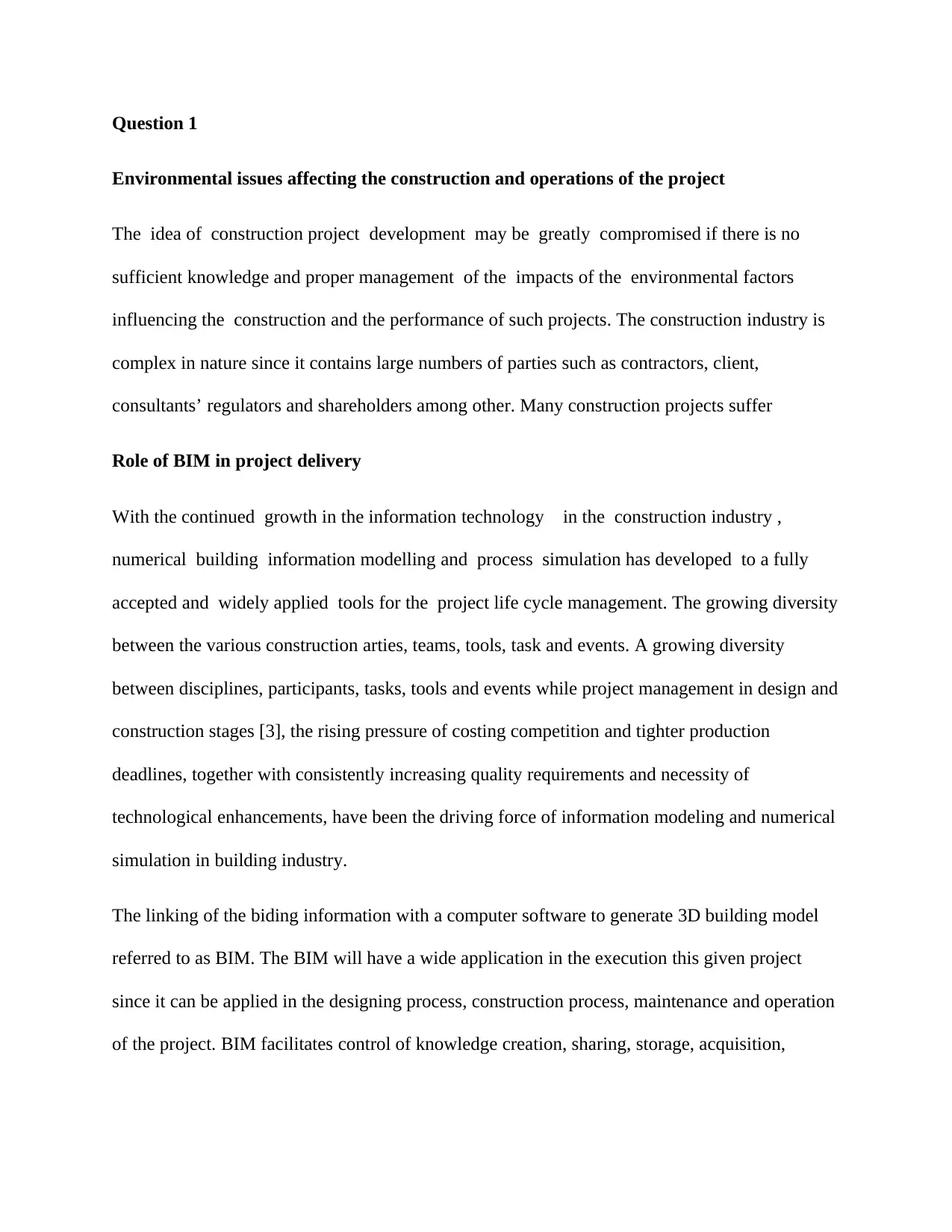
Question 1
Environmental issues affecting the construction and operations of the project
The idea of construction project development may be greatly compromised if there is no
sufficient knowledge and proper management of the impacts of the environmental factors
influencing the construction and the performance of such projects. The construction industry is
complex in nature since it contains large numbers of parties such as contractors, client,
consultants’ regulators and shareholders among other. Many construction projects suffer
Role of BIM in project delivery
With the continued growth in the information technology in the construction industry ,
numerical building information modelling and process simulation has developed to a fully
accepted and widely applied tools for the project life cycle management. The growing diversity
between the various construction arties, teams, tools, task and events. A growing diversity
between disciplines, participants, tasks, tools and events while project management in design and
construction stages [3], the rising pressure of costing competition and tighter production
deadlines, together with consistently increasing quality requirements and necessity of
technological enhancements, have been the driving force of information modeling and numerical
simulation in building industry.
The linking of the biding information with a computer software to generate 3D building model
referred to as BIM. The BIM will have a wide application in the execution this given project
since it can be applied in the designing process, construction process, maintenance and operation
of the project. BIM facilitates control of knowledge creation, sharing, storage, acquisition,
Environmental issues affecting the construction and operations of the project
The idea of construction project development may be greatly compromised if there is no
sufficient knowledge and proper management of the impacts of the environmental factors
influencing the construction and the performance of such projects. The construction industry is
complex in nature since it contains large numbers of parties such as contractors, client,
consultants’ regulators and shareholders among other. Many construction projects suffer
Role of BIM in project delivery
With the continued growth in the information technology in the construction industry ,
numerical building information modelling and process simulation has developed to a fully
accepted and widely applied tools for the project life cycle management. The growing diversity
between the various construction arties, teams, tools, task and events. A growing diversity
between disciplines, participants, tasks, tools and events while project management in design and
construction stages [3], the rising pressure of costing competition and tighter production
deadlines, together with consistently increasing quality requirements and necessity of
technological enhancements, have been the driving force of information modeling and numerical
simulation in building industry.
The linking of the biding information with a computer software to generate 3D building model
referred to as BIM. The BIM will have a wide application in the execution this given project
since it can be applied in the designing process, construction process, maintenance and operation
of the project. BIM facilitates control of knowledge creation, sharing, storage, acquisition,
Secure Best Marks with AI Grader
Need help grading? Try our AI Grader for instant feedback on your assignments.

dissemination and the application to the current project. The figure below shows BIM knowledge
management cycle.
Application of BIM during planning stage
The activities which are involved in project planning will include master planning and urban
design, master planning refers to the regulatory framework which will control the
development of the collection of project components with the overall consideration for their
massing, connectivity, relationships and heights. He regulatory framework will give sufficient
details in the context of the social , environmental , economic, security, services and
infrastructure. All the information regarding to the above project components will be gathered
and be stored in the BIM repository. The stored data will be of great importance in the
management cycle.
Application of BIM during planning stage
The activities which are involved in project planning will include master planning and urban
design, master planning refers to the regulatory framework which will control the
development of the collection of project components with the overall consideration for their
massing, connectivity, relationships and heights. He regulatory framework will give sufficient
details in the context of the social , environmental , economic, security, services and
infrastructure. All the information regarding to the above project components will be gathered
and be stored in the BIM repository. The stored data will be of great importance in the
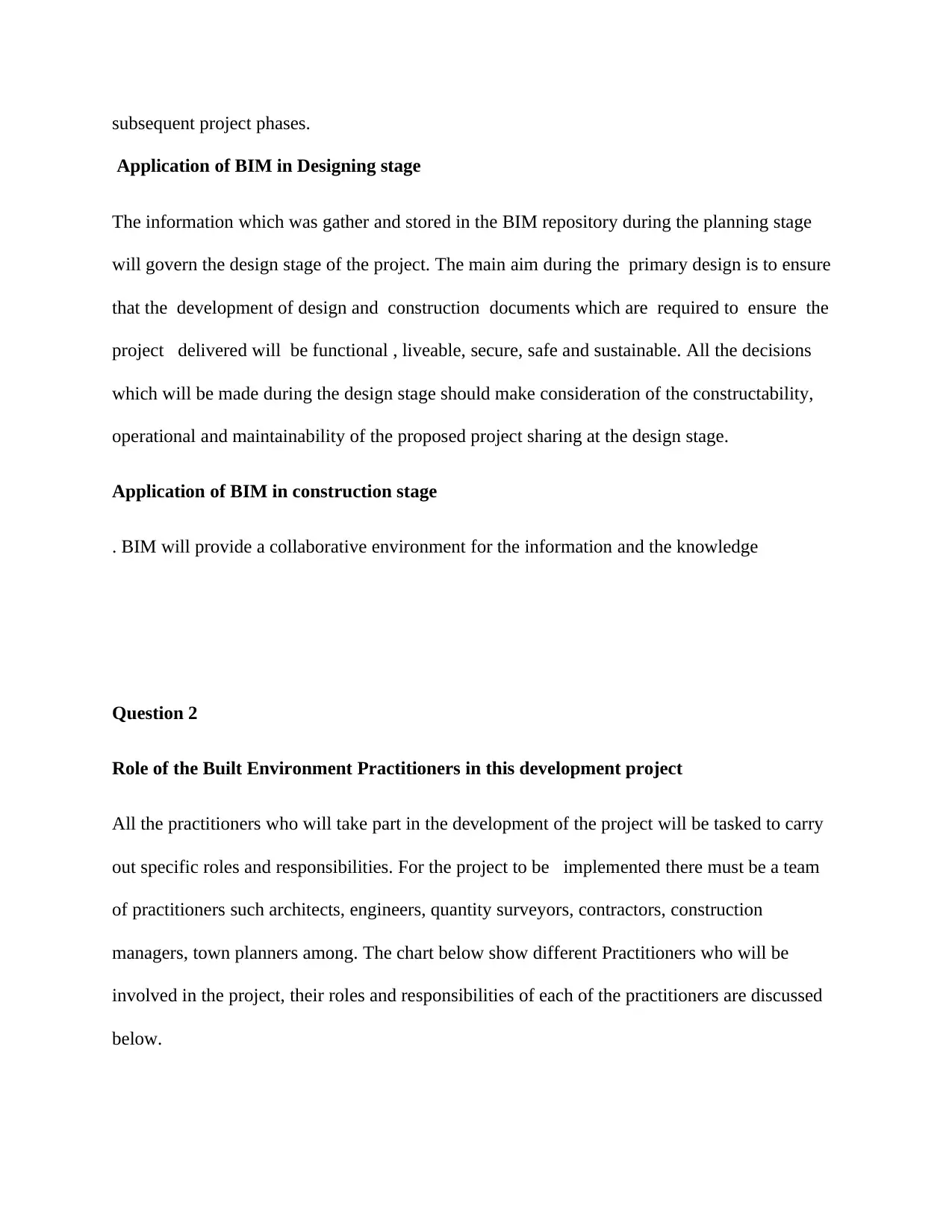
subsequent project phases.
Application of BIM in Designing stage
The information which was gather and stored in the BIM repository during the planning stage
will govern the design stage of the project. The main aim during the primary design is to ensure
that the development of design and construction documents which are required to ensure the
project delivered will be functional , liveable, secure, safe and sustainable. All the decisions
which will be made during the design stage should make consideration of the constructability,
operational and maintainability of the proposed project sharing at the design stage.
Application of BIM in construction stage
. BIM will provide a collaborative environment for the information and the knowledge
Question 2
Role of the Built Environment Practitioners in this development project
All the practitioners who will take part in the development of the project will be tasked to carry
out specific roles and responsibilities. For the project to be implemented there must be a team
of practitioners such architects, engineers, quantity surveyors, contractors, construction
managers, town planners among. The chart below show different Practitioners who will be
involved in the project, their roles and responsibilities of each of the practitioners are discussed
below.
Application of BIM in Designing stage
The information which was gather and stored in the BIM repository during the planning stage
will govern the design stage of the project. The main aim during the primary design is to ensure
that the development of design and construction documents which are required to ensure the
project delivered will be functional , liveable, secure, safe and sustainable. All the decisions
which will be made during the design stage should make consideration of the constructability,
operational and maintainability of the proposed project sharing at the design stage.
Application of BIM in construction stage
. BIM will provide a collaborative environment for the information and the knowledge
Question 2
Role of the Built Environment Practitioners in this development project
All the practitioners who will take part in the development of the project will be tasked to carry
out specific roles and responsibilities. For the project to be implemented there must be a team
of practitioners such architects, engineers, quantity surveyors, contractors, construction
managers, town planners among. The chart below show different Practitioners who will be
involved in the project, their roles and responsibilities of each of the practitioners are discussed
below.
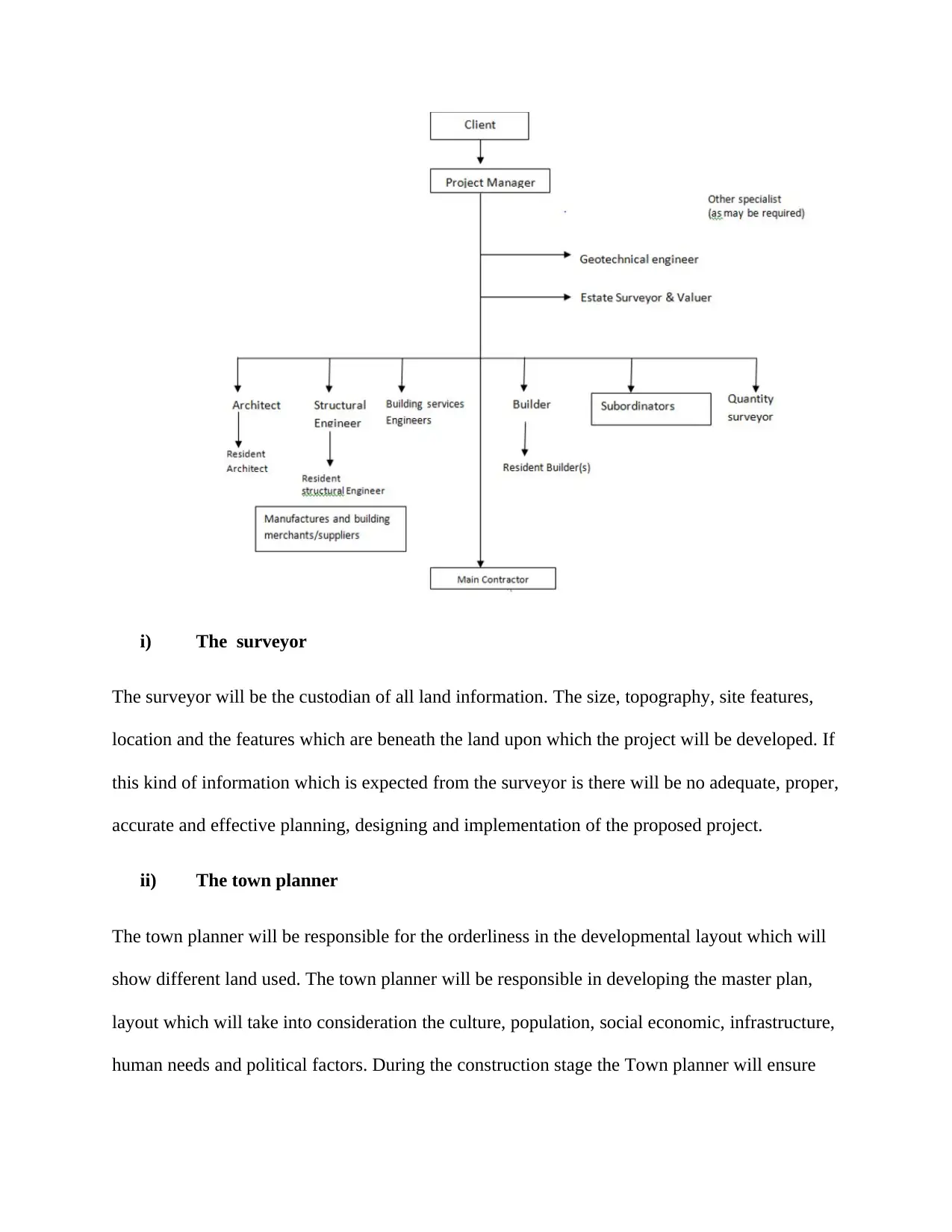
i) The surveyor
The surveyor will be the custodian of all land information. The size, topography, site features,
location and the features which are beneath the land upon which the project will be developed. If
this kind of information which is expected from the surveyor is there will be no adequate, proper,
accurate and effective planning, designing and implementation of the proposed project.
ii) The town planner
The town planner will be responsible for the orderliness in the developmental layout which will
show different land used. The town planner will be responsible in developing the master plan,
layout which will take into consideration the culture, population, social economic, infrastructure,
human needs and political factors. During the construction stage the Town planner will ensure
The surveyor will be the custodian of all land information. The size, topography, site features,
location and the features which are beneath the land upon which the project will be developed. If
this kind of information which is expected from the surveyor is there will be no adequate, proper,
accurate and effective planning, designing and implementation of the proposed project.
ii) The town planner
The town planner will be responsible for the orderliness in the developmental layout which will
show different land used. The town planner will be responsible in developing the master plan,
layout which will take into consideration the culture, population, social economic, infrastructure,
human needs and political factors. During the construction stage the Town planner will ensure
Secure Best Marks with AI Grader
Need help grading? Try our AI Grader for instant feedback on your assignments.
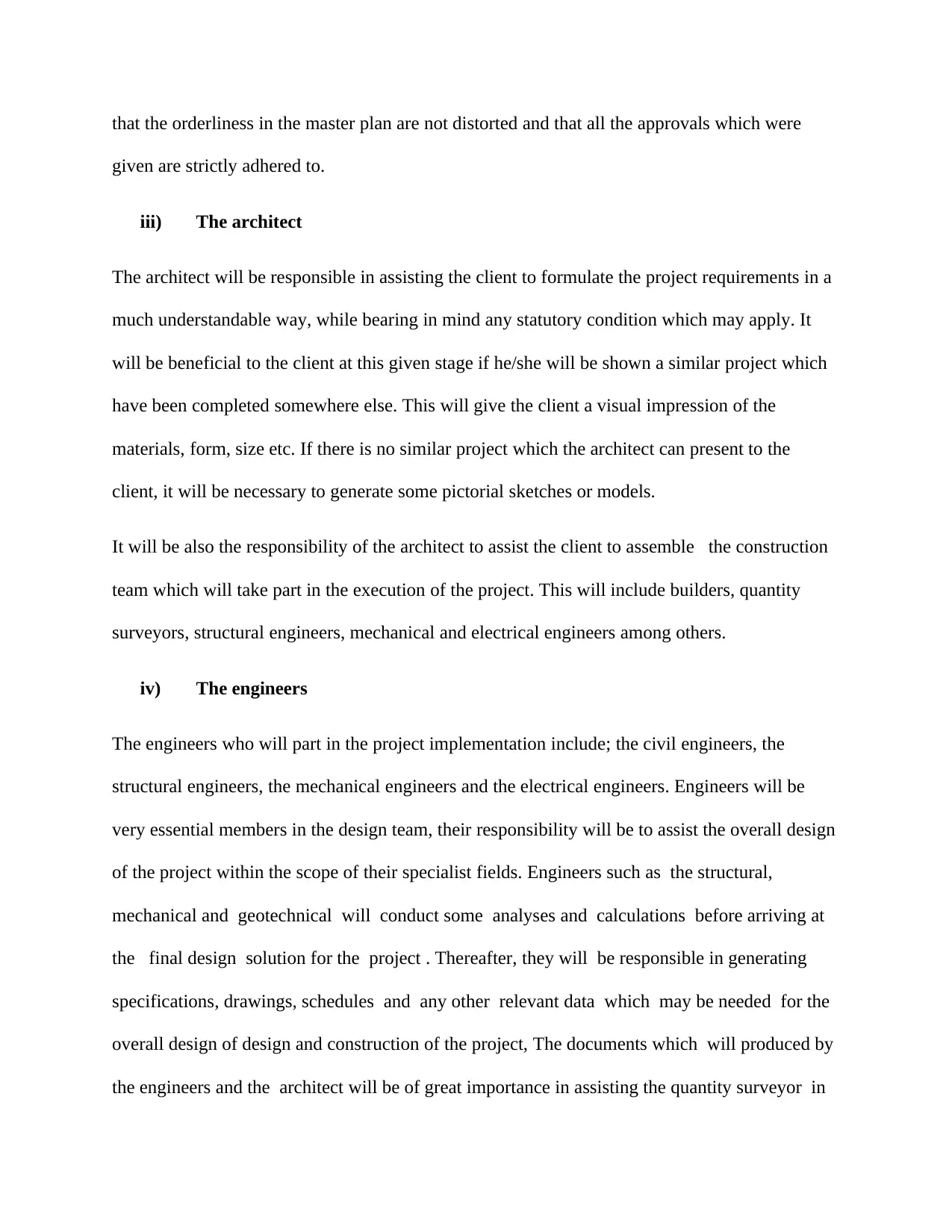
that the orderliness in the master plan are not distorted and that all the approvals which were
given are strictly adhered to.
iii) The architect
The architect will be responsible in assisting the client to formulate the project requirements in a
much understandable way, while bearing in mind any statutory condition which may apply. It
will be beneficial to the client at this given stage if he/she will be shown a similar project which
have been completed somewhere else. This will give the client a visual impression of the
materials, form, size etc. If there is no similar project which the architect can present to the
client, it will be necessary to generate some pictorial sketches or models.
It will be also the responsibility of the architect to assist the client to assemble the construction
team which will take part in the execution of the project. This will include builders, quantity
surveyors, structural engineers, mechanical and electrical engineers among others.
iv) The engineers
The engineers who will part in the project implementation include; the civil engineers, the
structural engineers, the mechanical engineers and the electrical engineers. Engineers will be
very essential members in the design team, their responsibility will be to assist the overall design
of the project within the scope of their specialist fields. Engineers such as the structural,
mechanical and geotechnical will conduct some analyses and calculations before arriving at
the final design solution for the project . Thereafter, they will be responsible in generating
specifications, drawings, schedules and any other relevant data which may be needed for the
overall design of design and construction of the project, The documents which will produced by
the engineers and the architect will be of great importance in assisting the quantity surveyor in
given are strictly adhered to.
iii) The architect
The architect will be responsible in assisting the client to formulate the project requirements in a
much understandable way, while bearing in mind any statutory condition which may apply. It
will be beneficial to the client at this given stage if he/she will be shown a similar project which
have been completed somewhere else. This will give the client a visual impression of the
materials, form, size etc. If there is no similar project which the architect can present to the
client, it will be necessary to generate some pictorial sketches or models.
It will be also the responsibility of the architect to assist the client to assemble the construction
team which will take part in the execution of the project. This will include builders, quantity
surveyors, structural engineers, mechanical and electrical engineers among others.
iv) The engineers
The engineers who will part in the project implementation include; the civil engineers, the
structural engineers, the mechanical engineers and the electrical engineers. Engineers will be
very essential members in the design team, their responsibility will be to assist the overall design
of the project within the scope of their specialist fields. Engineers such as the structural,
mechanical and geotechnical will conduct some analyses and calculations before arriving at
the final design solution for the project . Thereafter, they will be responsible in generating
specifications, drawings, schedules and any other relevant data which may be needed for the
overall design of design and construction of the project, The documents which will produced by
the engineers and the architect will be of great importance in assisting the quantity surveyor in
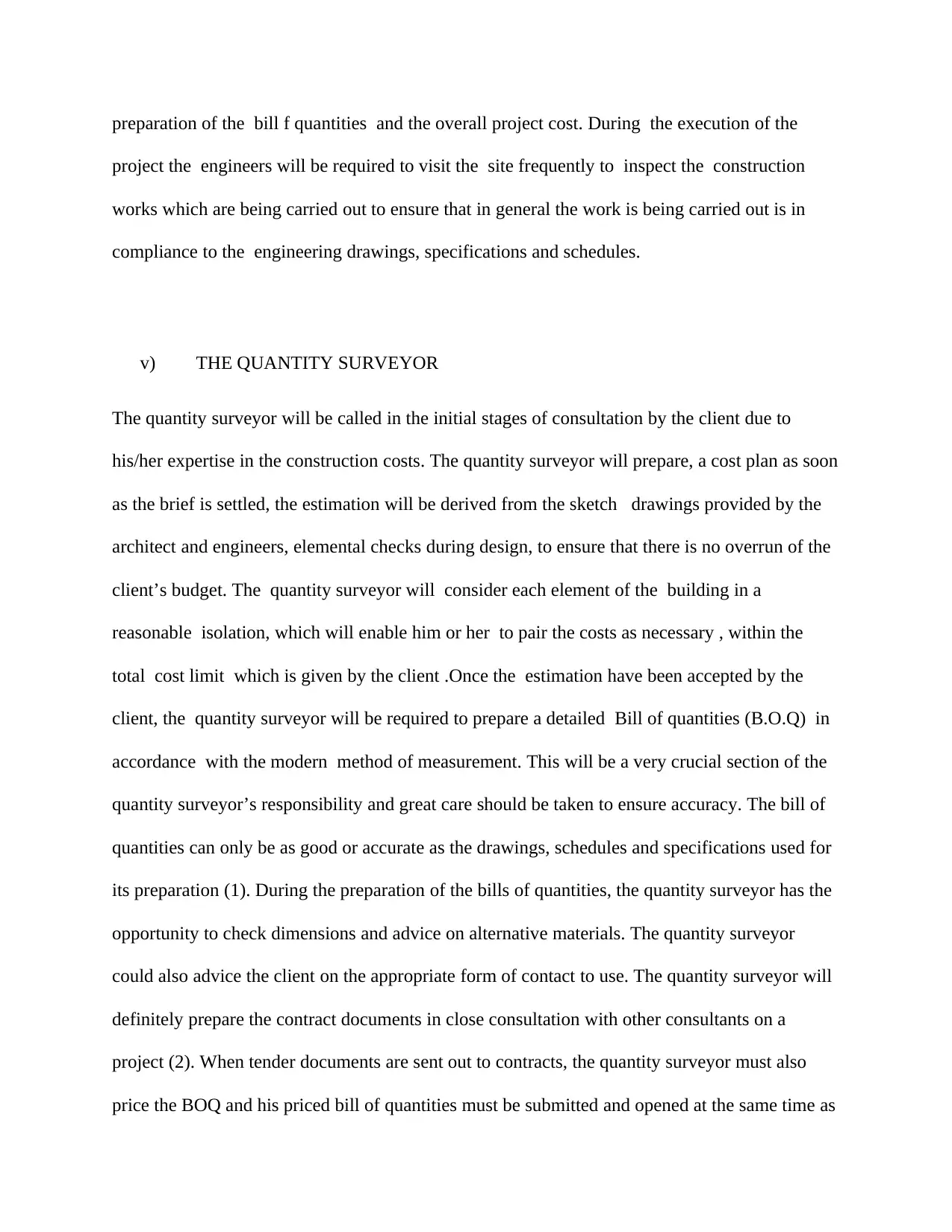
preparation of the bill f quantities and the overall project cost. During the execution of the
project the engineers will be required to visit the site frequently to inspect the construction
works which are being carried out to ensure that in general the work is being carried out is in
compliance to the engineering drawings, specifications and schedules.
v) THE QUANTITY SURVEYOR
The quantity surveyor will be called in the initial stages of consultation by the client due to
his/her expertise in the construction costs. The quantity surveyor will prepare, a cost plan as soon
as the brief is settled, the estimation will be derived from the sketch drawings provided by the
architect and engineers, elemental checks during design, to ensure that there is no overrun of the
client’s budget. The quantity surveyor will consider each element of the building in a
reasonable isolation, which will enable him or her to pair the costs as necessary , within the
total cost limit which is given by the client .Once the estimation have been accepted by the
client, the quantity surveyor will be required to prepare a detailed Bill of quantities (B.O.Q) in
accordance with the modern method of measurement. This will be a very crucial section of the
quantity surveyor’s responsibility and great care should be taken to ensure accuracy. The bill of
quantities can only be as good or accurate as the drawings, schedules and specifications used for
its preparation (1). During the preparation of the bills of quantities, the quantity surveyor has the
opportunity to check dimensions and advice on alternative materials. The quantity surveyor
could also advice the client on the appropriate form of contact to use. The quantity surveyor will
definitely prepare the contract documents in close consultation with other consultants on a
project (2). When tender documents are sent out to contracts, the quantity surveyor must also
price the BOQ and his priced bill of quantities must be submitted and opened at the same time as
project the engineers will be required to visit the site frequently to inspect the construction
works which are being carried out to ensure that in general the work is being carried out is in
compliance to the engineering drawings, specifications and schedules.
v) THE QUANTITY SURVEYOR
The quantity surveyor will be called in the initial stages of consultation by the client due to
his/her expertise in the construction costs. The quantity surveyor will prepare, a cost plan as soon
as the brief is settled, the estimation will be derived from the sketch drawings provided by the
architect and engineers, elemental checks during design, to ensure that there is no overrun of the
client’s budget. The quantity surveyor will consider each element of the building in a
reasonable isolation, which will enable him or her to pair the costs as necessary , within the
total cost limit which is given by the client .Once the estimation have been accepted by the
client, the quantity surveyor will be required to prepare a detailed Bill of quantities (B.O.Q) in
accordance with the modern method of measurement. This will be a very crucial section of the
quantity surveyor’s responsibility and great care should be taken to ensure accuracy. The bill of
quantities can only be as good or accurate as the drawings, schedules and specifications used for
its preparation (1). During the preparation of the bills of quantities, the quantity surveyor has the
opportunity to check dimensions and advice on alternative materials. The quantity surveyor
could also advice the client on the appropriate form of contact to use. The quantity surveyor will
definitely prepare the contract documents in close consultation with other consultants on a
project (2). When tender documents are sent out to contracts, the quantity surveyor must also
price the BOQ and his priced bill of quantities must be submitted and opened at the same time as
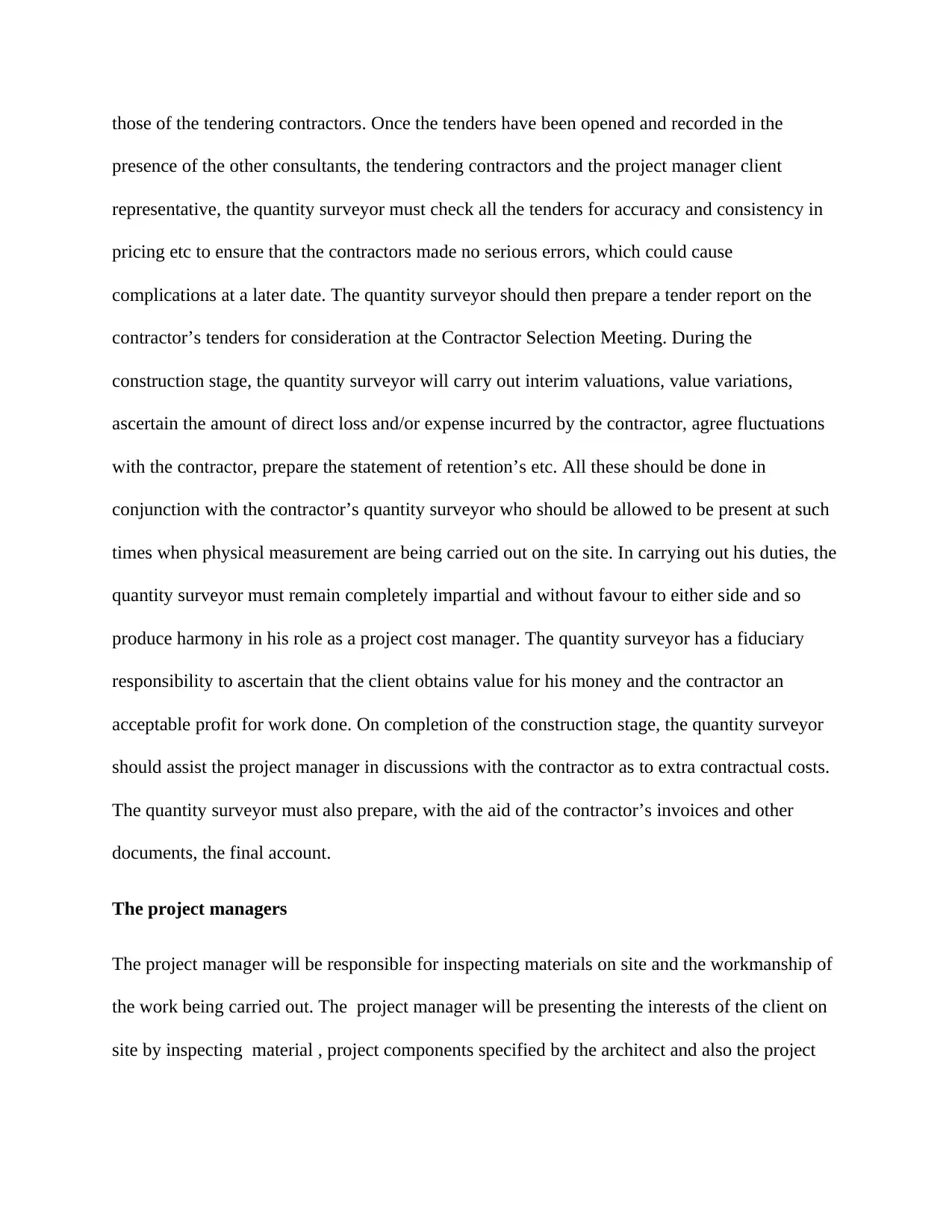
those of the tendering contractors. Once the tenders have been opened and recorded in the
presence of the other consultants, the tendering contractors and the project manager client
representative, the quantity surveyor must check all the tenders for accuracy and consistency in
pricing etc to ensure that the contractors made no serious errors, which could cause
complications at a later date. The quantity surveyor should then prepare a tender report on the
contractor’s tenders for consideration at the Contractor Selection Meeting. During the
construction stage, the quantity surveyor will carry out interim valuations, value variations,
ascertain the amount of direct loss and/or expense incurred by the contractor, agree fluctuations
with the contractor, prepare the statement of retention’s etc. All these should be done in
conjunction with the contractor’s quantity surveyor who should be allowed to be present at such
times when physical measurement are being carried out on the site. In carrying out his duties, the
quantity surveyor must remain completely impartial and without favour to either side and so
produce harmony in his role as a project cost manager. The quantity surveyor has a fiduciary
responsibility to ascertain that the client obtains value for his money and the contractor an
acceptable profit for work done. On completion of the construction stage, the quantity surveyor
should assist the project manager in discussions with the contractor as to extra contractual costs.
The quantity surveyor must also prepare, with the aid of the contractor’s invoices and other
documents, the final account.
The project managers
The project manager will be responsible for inspecting materials on site and the workmanship of
the work being carried out. The project manager will be presenting the interests of the client on
site by inspecting material , project components specified by the architect and also the project
presence of the other consultants, the tendering contractors and the project manager client
representative, the quantity surveyor must check all the tenders for accuracy and consistency in
pricing etc to ensure that the contractors made no serious errors, which could cause
complications at a later date. The quantity surveyor should then prepare a tender report on the
contractor’s tenders for consideration at the Contractor Selection Meeting. During the
construction stage, the quantity surveyor will carry out interim valuations, value variations,
ascertain the amount of direct loss and/or expense incurred by the contractor, agree fluctuations
with the contractor, prepare the statement of retention’s etc. All these should be done in
conjunction with the contractor’s quantity surveyor who should be allowed to be present at such
times when physical measurement are being carried out on the site. In carrying out his duties, the
quantity surveyor must remain completely impartial and without favour to either side and so
produce harmony in his role as a project cost manager. The quantity surveyor has a fiduciary
responsibility to ascertain that the client obtains value for his money and the contractor an
acceptable profit for work done. On completion of the construction stage, the quantity surveyor
should assist the project manager in discussions with the contractor as to extra contractual costs.
The quantity surveyor must also prepare, with the aid of the contractor’s invoices and other
documents, the final account.
The project managers
The project manager will be responsible for inspecting materials on site and the workmanship of
the work being carried out. The project manager will be presenting the interests of the client on
site by inspecting material , project components specified by the architect and also the project
Paraphrase This Document
Need a fresh take? Get an instant paraphrase of this document with our AI Paraphraser
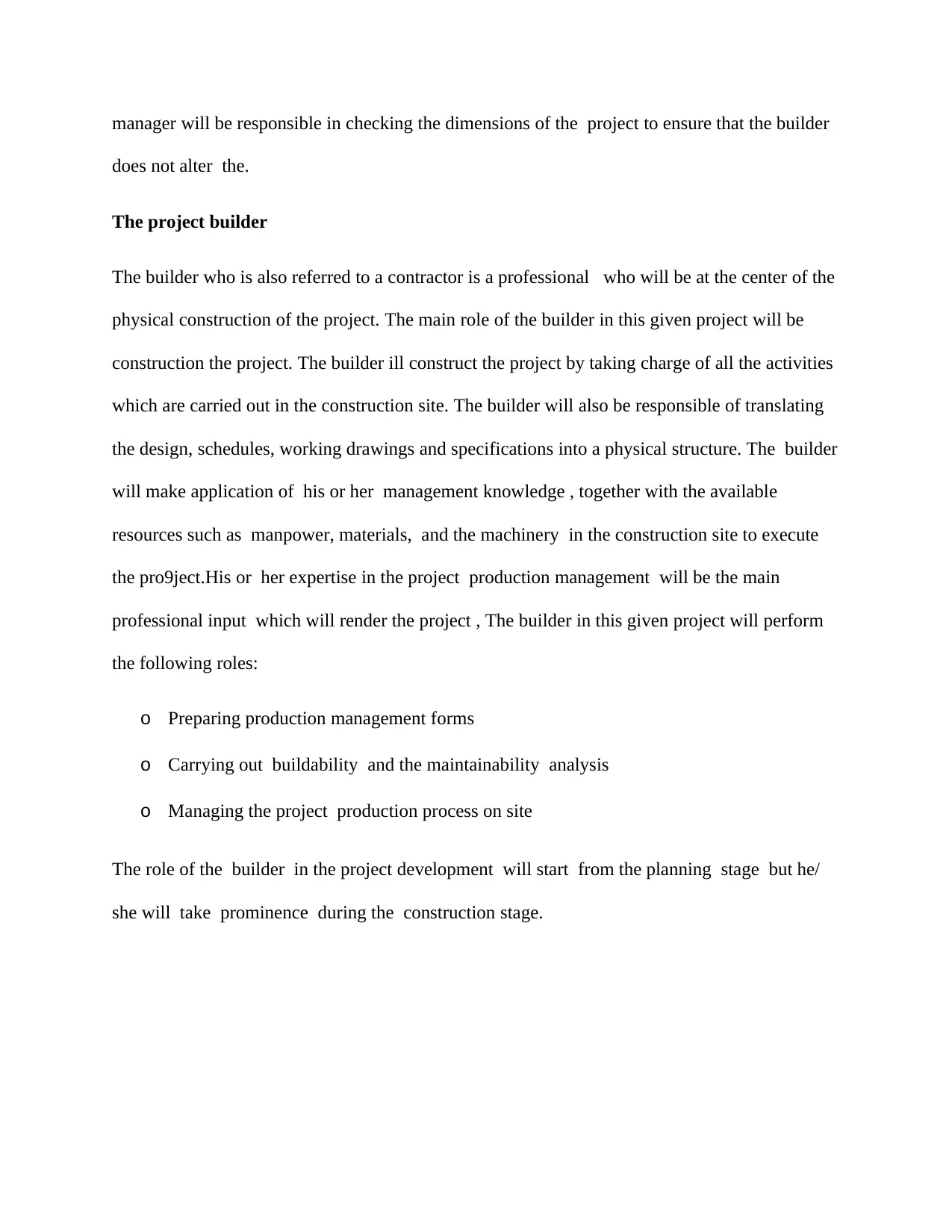
manager will be responsible in checking the dimensions of the project to ensure that the builder
does not alter the.
The project builder
The builder who is also referred to a contractor is a professional who will be at the center of the
physical construction of the project. The main role of the builder in this given project will be
construction the project. The builder ill construct the project by taking charge of all the activities
which are carried out in the construction site. The builder will also be responsible of translating
the design, schedules, working drawings and specifications into a physical structure. The builder
will make application of his or her management knowledge , together with the available
resources such as manpower, materials, and the machinery in the construction site to execute
the pro9ject.His or her expertise in the project production management will be the main
professional input which will render the project , The builder in this given project will perform
the following roles:
o Preparing production management forms
o Carrying out buildability and the maintainability analysis
o Managing the project production process on site
The role of the builder in the project development will start from the planning stage but he/
she will take prominence during the construction stage.
does not alter the.
The project builder
The builder who is also referred to a contractor is a professional who will be at the center of the
physical construction of the project. The main role of the builder in this given project will be
construction the project. The builder ill construct the project by taking charge of all the activities
which are carried out in the construction site. The builder will also be responsible of translating
the design, schedules, working drawings and specifications into a physical structure. The builder
will make application of his or her management knowledge , together with the available
resources such as manpower, materials, and the machinery in the construction site to execute
the pro9ject.His or her expertise in the project production management will be the main
professional input which will render the project , The builder in this given project will perform
the following roles:
o Preparing production management forms
o Carrying out buildability and the maintainability analysis
o Managing the project production process on site
The role of the builder in the project development will start from the planning stage but he/
she will take prominence during the construction stage.

1 out of 9
Related Documents
Your All-in-One AI-Powered Toolkit for Academic Success.
+13062052269
info@desklib.com
Available 24*7 on WhatsApp / Email
![[object Object]](/_next/static/media/star-bottom.7253800d.svg)
Unlock your academic potential
© 2024 | Zucol Services PVT LTD | All rights reserved.




